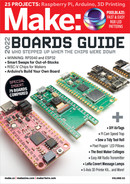
Why is this? Because the coil is not connected
in any way with the transmitter circuit. It cannot
“see” the 9V supply and 0V negative ground on
the breadboard. All it knows is that the high
frequency fluctuates up and down, interspersed
with intervals of no voltage.
What would you hear if the diode wasn’t in the
circuit? Nothing! You can test this yourself by
shorting out the diode with a piece of wire.
The diaphragm in the earphone cannot vibrate
at the carrier frequency because the oscillations
are much too fast — and even if the earphone
could reproduce them, they are too fast for your
ear to resolve them as sound. Moreover, the
oscillations are equally positive and negative, so
they add up to an average of zero.
But when you pass the output from the
coil through a diode, the negative half of each
oscillation is blocked, and only the positive part
flows through. This is known as rectifying the
signal.
You can think of all of the tiny, rapid, positive
pulses of the carrier frequency pushing the
diaphragm of the earphone in one direction. Then
there’s a pause (lasting a fraction of a second),
and the diaphragm relaxes. This happens at the
audio frequency set by IC1. You can see this in
Figure
O
, which is an oscilloscope trace taken
from the wires to the earphone. The earphone —
the audio signal — “rides the peaks” of each burst
of carrier frequency.
This article is adapted from our book in
progress, Make: Radio, forthcoming in
2023 and available for pre-order now at
the Maker Shed, makershed.com.
Charles Platt, Adobe Stock-Archivist
A WORD ABOUT TESLA
It's easy to imagine how Nikola Tesla made
an intuitive leap and wanted to crank
up a radio transmission so that it would
broadcast serious electrical power. His
most ambitious installation, in Colorado
Springs, used a coil 100 feet in diameter
which created a potential of up to 12 million
volts. It broadcast sufficient power to light a
fluorescent tube equipped with an antenna,
25 miles away. It also drove horses crazy by
inducing electric shocks in the iron shoes on
their hooves.
This was a time when many aspects
of electricity and physics were not fully
understood, and there were competing
theories. Unfortunately, Tesla pinned his
hopes on some theories that turned out to
be wrong. He believed empty space wasn’t
really empty, but was filled with an invisible,
mysterious substance known as “ether.” He
hoped, incorrectly, that if he tapped into the
ether at the right frequency, infinite power
was available. This turned out not to be the
case.
If he had devoted less time and effort to his
dream of infinite electrical power, probably
he could have won the race to transmit a
radio message across the Atlantic. Marconi
ended up with that achievement, but Tesla
had a more powerful transmitter, a larger
antenna, and a more sophisticated receiver.
He just didn't think that radio messages were
as interesting as free electricity.
69
make.co
M83_062-69_BookEx-Radio_F1.indd 69M83_062-69_BookEx-Radio_F1.indd 69 10/10/22 3:33 PM10/10/22 3:33 PM
..................Content has been hidden....................
You can't read the all page of ebook, please click here login for view all page.
